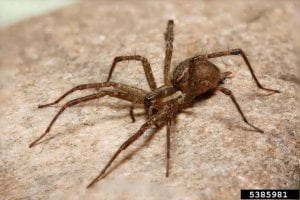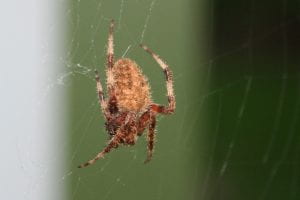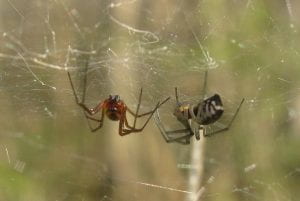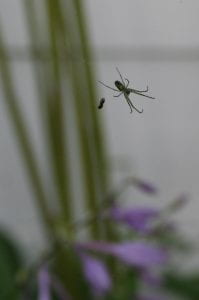By Sharon Lunden, Goshen Master Gardener Volunteer

Welcome to autumn, time for falling leaves, pumpkin spice everything, candy corn and… spiders! Fall is spider mating season, so they are more visible this time of year. Typically it is the female you will notice since the males are on the move to find a suitable mate. Whether you find spiders beautiful or frightening, they are an important part of our world. Allow me introduce you to a few of our area’s eight legged residents, so you, too, can appreciate them.
Note: When measuring spiders only the body length is measured, the legs are not included in the measurement.

Have you noticed a dewy webs stretching across the surface of your shrubs, grass, or ground cover? This may have been created by a funnel weaver, or grass spider, in the family Agelenidae. Spiders in this family build large webs that resemble a small sheet, but with a small funnel on one side. These webs are not sticky themselves, but provide both a place to hide and a platform for this fast-moving spider to capture an unsuspecting insect after it is knocked into the web by a network of other threads strategically placed above the sheet. You’re more likely to see the web than its yellow brown builder unless you pay close attention or find one indoors as they seek warmth during the increasingly cold weather. These spiders measure anywhere from 9 to 20 mm (⅓ to ¾ inch) length, males being slightly smaller than females, and are recognized by long spinnerets on the back of their abdomen and distinctive striping on the top side of their cephalothorax.

Spiders in the Linyphiidae family are also sheet web weavers, but they are much smaller (1 to 8.5 mm / 0.04 to ⅓ inch) and less noticeable. Theses spiders build a flat sheet, sometime in two layers, and hide underneath, ready to capture its prey, running out to bite and immobilize any insect that lands. These are some of the most common spiders found in vegetation.

The orchard orb weaver (Leucauge venusta) belongs to the Tetragnathidae family. It is a small (3.5 to 7 mm / ⅒ to ¼ inch), pretty green spider with orange markings. As you might guess, they are commonly found in orchards, woodland edges, and under the overhanging eves of structures situated near hedges or gardens. They usually create horizontal orb webs and rest on underside of the center to wait for dinner. Unlike many solitary spiders, sometimes, when prey is abundant, these spiders will attach their webs together.

Some of the more intimidating visitor to the garden are spiders from one of the largest spider family, the Araneidae or true orb weavers. Specimens from this ancient family have been found in amber dating back to 121-115 million years ago. These spiders are usually most active at night, which is when they build their large, round (orb) shaped webs used to catch night flying insects. Typically, they are shades of brown and gray and vary in size measuring from 6 to over 25 mm in length (¼ to 1 inch). Their leg segments often have alternating colors given them a striped pattern and they frequently have highly patterned abdomens like the pictured Araneus diadametus.

Spider silk is created in spinnerets, located at the rear of the spider’s abdomen. It is used not only to capture dinner, but also for transportation, finding a suitable mate, and for shelter. Some orb weavers even use silk is to create a daytime hiding place by using it to binding a leaf together.
Some spiders may produce several types of webbing silk. Orb weavers use a non-sticky silk to build the radial threads and outer frame of their web (like bicycle spokes and rim) and a sticky silk to fill in, used to catch prey. Orb weavers often have a conspicuous zig-zag pattern built into their web called a stabilimentum. Although the function of the stabilimentum is not well understood, some scientists hypothesis that it may attract prey through an ultraviolet fluorescence. Unseen to the human eye ultraviolet light is visible to many insects, and many flowers reflect ultra violet light to attract pollinators.

My favorite orb weaver is the black and yellow garden spider(Argiope aurantia). This spider is a striking sight in the garden. The females are among the largest spiders in New York State, with their bodies measuring up to 30 mm in length (1¼ inches). Like many spiders they are sexually dimorphic meaning the males and females have different forms. Unlike the females, the males are tiny only measuring up to 8 mm (⅓ inch). Theses spiders prefer sunny spots in fields and gardens, building large webs which include a long zig-zag pattern which some believe helps birds to avoid being caught in the web, a catch larger than even this spider can handle. Each web is rebuilt every morning so that the web remains sticky.
Though many of us have a natural instinct to fear spiders, it is important to recognize their contribution to our world and to appreciate that that they dine on many pests and are generally not aggressive. If you find a spider has built a web near the entrance to your home or vehicle, get close enough that the spider retreats elsewhere, then clear away the web. Eventually they will get the hint and relocate. Please do not commit arachnicide! With time you may even consider these eight legged creatures a beautiful and welcome guest in your garden.
Spider References
Common Spiders of New York – NYS Department of Environmental Conservation
Grass Spiders – Penn State Extension
Spiders in New York – Spider ID
